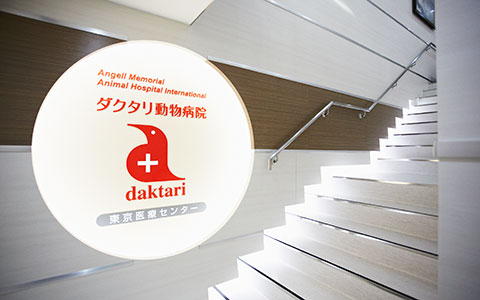We offer 24/7 emergency veterinary services to handle urgent illnesses and injuries. Whether you are a first-time visitor or referred by your regular veterinarian, we are here to assist you.
To ensure prompt and appropriate treatment, please call us prior to your visit.
Address: 2F Shirokane-dai Apartment, 5-14-1 Shirokane-dai, Minato-ku, Tokyo
24/7 Emergency Medical Service
At our clinic, we provide emergency medical care for animals 24/7, 365 days. This is a rare setup nationwide in Japan.
Key Features of Our Emergency Medical Care:
- Real 24/7 Availability: Unlike many nighttime emergency animal hospitals that require referral to a daytime primary care veterinarian, we offer consistent emergency response and intensive care.
- Strength as Primary Care Providers: Being a primary care hospital capable of 24-hour emergency response allows us to provide appropriate treatment based on comprehensive knowledge of the patient animals’ medical histories and characteristics.
- Wide Range of Expertise: From internal medicine to surgery, we promptly address various emergency situations and maintain a system to protect lives that can be saved.
What is Emergency Medical Care?
Emergency medical care refers to medical treatment for unforeseen illnesses or injuries. In the case of animals, sudden changes in health are not uncommon. Diseases and accidents do not choose the timing, making our emergency medical care available at all times highly valuable.
Determining Whether to Seek Consultation
If you are unsure whether to seek consultation, please feel free to call us. We will assess the situation and advise whether immediate consultation is necessary.
Symptoms Requiring Emergency Consultation
Please contact us immediately if you observe the following symptoms:
- Lethargy
- Respiratory distress or cessation
- Unconsciousness
- Inability to stand up
- Elevated body temperature
- Purple tongue
- Persistent coughing
- Multiple episodes of vomiting
- Black diarrhea
- Lack of urination
- First-time or prolonged/frequent seizures
- Falls from heights or traffic accidents
- Unstoppable bleeding
- Eye abnormalities
- Sudden weakness in hind limbs
- Ingestion of foreign objects or toxins
Common Emergency Conditions:
Our clinic handles the following highly urgent conditions:
- Cardiogenic pulmonary edema
- Non-cardiogenic pulmonary edema
- Pneumonia
- Cardiac arrest
- Pneumothorax, pyothorax, chylothorax, pleural effusion
- Gastric dilatation-volvulus syndrome
- Urethral obstruction, urinary obstruction
- Acute kidney injury (AKI)
- Diabetic ketoacidosis
- Hypoglycemia
- Addison’s disease
- Dystocia, cesarean section
- Seizures/status epilepticus
- Intrabdominal hemorrhage
- Immune-mediated hemolytic anemia
- Shock (cardiogenic/septic/hypovolemic/obstructive)
- Anaphylaxis
- Heatstroke
- Trauma, burns, traffic accidents, falls
- Ingestion of foreign bodies, poisoning
- Intestinal obstruction
- Esophageal foreign bodies
- Glaucoma
- Retinal detachment
- Acute aortic thromboembolism
- Gallbladder rupture
- Biliary obstruction
- Acute pancreatitis
- Pyometra
- Intrabdominal hemorrhage (hemoabdomen)
- Feline infectious peritonitis (FIP)
With our 24/7 emergency response, our clinic is always prepared for emergencies involving animals. We prioritize the health and safety of animals and provide rapid and appropriate emergency medical care.
Case Studies
Electrocution
4 months, Pomeranian (male)
Emergency visit at night due to chewing on a cord. Presented with oral burns and concurrent pulmonary edema. Improved with symptomatic therapy including oxygen treatment and discharged safely after 3 days.
Tracheal Collapse
12 years, Pomeranian (spayed female)
Visit due to persistent honking cough. Severe tracheal collapse was diagnosed, and due to the potential for acute worsening from medication and procedures, dietary management was prioritized initially. Improvement in cough frequency was noted with weight loss. Subsequently, underwent tracheal stenting procedure at a specialized facility for further improvement.
Gallbladder Mucous Cystadenoma, Gallbladder Rupture
15 years, Miniature Dachshund (neutered male)
Visit due to frequent vomiting. Abdominal ultrasound revealed gallbladder mucous cystadenoma, pericholecystic inflammation with minimal ascites, and dilation of the common bile duct. Diagnosis of gallbladder rupture led to gallbladder removal surgery. Postoperative gastrointestinal symptoms were absent, and with improved appetite, discharged after 4 days of hospitalization.
Intestinal Obstruction
6 years, Cavalier King Charles Spaniel (spayed female)
Visit due to frequent vomiting. Ultrasound indicated findings suspicious of foreign body, prompting surgical removal. General condition post-surgery was uneventful without gastrointestinal symptoms, discharged in 3 days.
Diabetic Ketoacidosis
11 years, Mixed breed cat (neutered male)
Visit due to anorexia for 4 days and frequent vomiting. Blood tests revealed hyperglycemia and metabolic acidosis. Urine dipstick showed presence of glucose and ketones. Improved with insulin therapy and intravenous fluids. Discharged upon improvement of blood tests and clinical symptoms.
Esophageal Foreign Body
6 years, Norfolk Terrier (neutered male)
Appearing nauseous after eating dental chew. Chest X-ray suggested esophageal foreign body, confirmed by endoscopic removal. No postoperative gastrointestinal symptoms observed, discharged the following day.
Gastric Dilatation-Volvulus Syndrome
16 years, Dalmatian (neutered male)
Unable to vomit after a walk. Abdominal X-ray suspected gastric dilatation-volvulus, underwent emergency surgery for detorsion and gastropexy. No postoperative gastrointestinal symptoms were noted, discharged after surgery.
Cardiogenic Pulmonary Edema
10 years, Chihuahua (male)
Difficulty breathing with cyanotic tongue. Diagnosed with cardiogenic pulmonary edema via X-ray and ultrasound. Admitted to oxygen therapy and managed under general anesthesia with mechanical ventilation. Discharged on day 7 after recovery.
Cardiogenic Shock, Cardiogenic Pulmonary Edema
13 years, Chihuahua (female)
Labored breathing en route to the hospital, arrived in cardiac arrest. Immediate cardiopulmonary resuscitation upon arrival, self-resuscitated with restored heart rate. X-ray and ultrasound diagnosed cardiogenic pulmonary edema, managed under general anesthesia with mechanical ventilation for 14 hours. Discharged on day 8 and subsequently referred to a cardiac surgery center for mitral valve repair.


